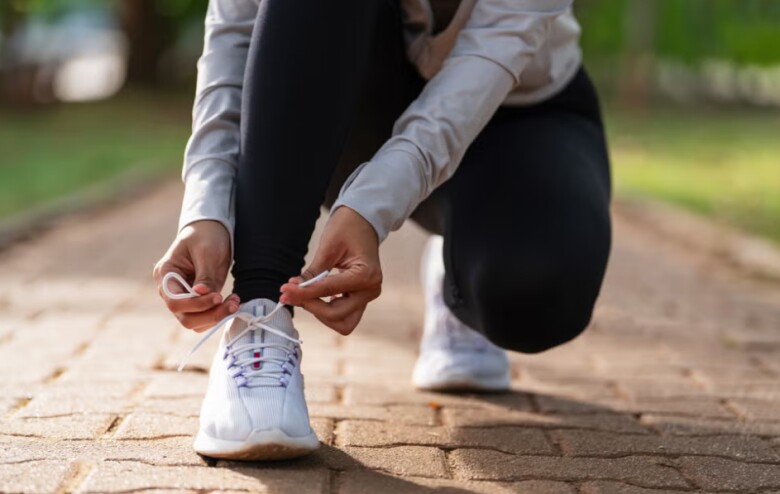Walking correctly is more than just exercise. Depending on the form, it can improve bone density, muscle endurance, enhance memory, and stabilize emotions. With advice from a UK fitness trainer and medical research, we’ve compiled the 8 most effective weight-loss walking techniques—easy to apply, maintain, and deliver noticeable results.
1. Brisk Walking
Brisk walking is more than just stepping faster than usual. At an average speed of 4–5.5 mph, this method requires proper posture: each step lands heel-first, then pushes off with the toe for the next stride.
Health coach Andrew Isaac notes, “Brisk walking is even more challenging than regular walking. Vigorous arm swings combined with powerful strides significantly increase heart rate, offering benefits comparable to a jogging session.”
Studies confirm that just 20 minutes of brisk walking daily can reduce heart disease risk and lower cholesterol. Even 10 minutes a day yields significant health benefits and supports effective fat burning.

2. Nordic Walking
Originating in Finland, Nordic walking was inspired by cross-country skiers’ summer training. Participants use specialized poles, moving forward while engaging the upper and core body muscles.
Compared to regular walking, Nordic walking activates more muscle groups, burning at least 20% more calories and enhancing fat loss. Its stable, upright posture, supported by poles, makes it safe for those with injuries, weak muscles, or knee pain.

3. Weighted Walking
To enhance daily walks, try adding weights. Use ankle or wrist weights, or a weighted vest, to increase resistance and intensity.
Weighted walking boosts muscle strength, especially in the hips, legs, and core, while accelerating fat burning and improving overall endurance. It transforms a regular walk into a blend of aerobic and strength training, ideal for building stamina or overcoming weight loss plateaus.
Added weight stresses joints, so maintain proper posture and stability. Beginners should start with light weights, gradually increasing over time.

4. Backward Walking
Though unusual, backward walking has long been used in rehabilitation and sports medicine. It’s not just a fun variation but offers surprising benefits.
Walking backward strengthens hamstrings and lower back muscles while reducing knee joint pressure, making it ideal for those with joint issues or osteoarthritis.
Additionally, this reverse motion activates underused neural pathways, improving reflexes and spatial awareness. A 2018 Dutch study found it enhances short-term memory and focus, making it a dual workout for body and mind.
Practice in safe, obstacle-free areas. Beginners should start with 3–5 minutes per session after familiarizing themselves with the route.

5. Yoga Walking
Yoga walking is more than exercise—it’s a mobile meditation. Combining steps, deep breathing, and mindfulness, it strengthens the body while grounding the mind in the present, offering tranquility amidst a busy life.
Incorporate gentle stretches, deep breathing, or pauses for reflection, creating a meditative experience. Choose a quiet, familiar route—like a neighborhood path—and avoid distractions like headphones or phones to fully embrace mental balance and recovery.

6. Long-Distance & Urban Hiking
Hiking isn’t limited to forests or beaches. You can enjoy its benefits in cities by choosing the right routes.
Explore parks, historical sites, or old streets. Instead of repetitive gym workouts, turn exercise into an exciting discovery journey.
Studies show varied, sloping terrain improves coordination, reduces fall risks, and lowers stress hormones.

7. Treadmill Walking
On rainy days or busy schedules, treadmills are perfect for maintaining walking habits. Control speed, incline, and duration, even incorporating interval training.
Treadmill walking is ideal for monitoring heart rate, improving aerobic endurance, and burning fat, especially for those with knee pain.
Try the 12-3-30 method: walk at a 12% incline, 3 mph for 30 minutes. Studies show regular treadmill use lowers blood pressure, visceral fat, and improves metabolic health—great for busy individuals managing weight at home.

8. Japanese Interval Walking
Developed by Japanese researchers, interval walking is a simple yet effective aerobic method. Walk briskly for 3 minutes at 70–85% max heart rate, then slow down for 3 minutes (40–50% heart rate). Repeat 5 times for 30 minutes total.
A 2007 Shinshu University study found this method improves aerobic endurance, lower body strength, and lowers blood pressure more than continuous brisk walking.
Interval walking isn’t just for runners. Mastering rhythm and breath turns it into a powerful fat-burning tool.































